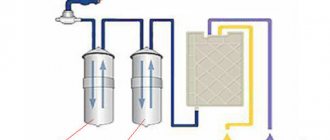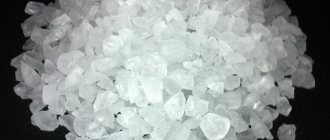Water is the source of life, the existence of the planet and all living things on it. It is an important part of the human body. When considering water as a physical object, scientists use such characteristics as density and heat capacity. But if everything is more or less clear with the first quantity, then a lot of questions arise about the heat capacity of water.
The concept of heat capacity
Heat capacity is a term used to indicate the amount of heat that a heated or cooled body (physical object) can absorb or release. To determine the heat capacity of a particular substance or object, the amount of absorbed or released heat in an infinitely minimal period of time and the duration of the measurement are correlated.
In physics, this process is also characterized by the relationship between an infinitesimal amount of heat and an equally small amount of temperature.
Heat capacity is measured in Joules - “J”, denoted by the capital letter “C”. Heat capacity is a dependent and variable quantity, since it is proportional to the substance contained in it. The greater the body mass, the more energy and heat is needed to heat it. Thus, temperature and mass are the main characteristics that need to be known to determine the heat capacity of a body. When measuring, it is also necessary to know the air temperature and pressure.
Other conditions
According to problem 2, the energy of an extra-systemic unit is given. It is necessary to determine the temperature at which 5 liters of water will cool if it is initially taken at boiling point. At the same time, it emits 1684 kJ of heat. This amount is converted to joules = 1680000 J.
To find the answer, you need to use a formula that uses mass. On the other hand, it is not given in the problem. But despite this, the volume of liquid is indicated; accordingly, to find the criterion, it is permissible to substitute an equation with coefficients:
Its density is 1000 kg per m3. But you need to substitute the volume in cubic meters. To convert the original value, you need to divide it by 1000. The result is a number equal to 0.005 m3.
Further calculations are carried out, and the output is the expression:
The following formula is used:
The result is a mark equal to 20 ºС.
Another problem: there is a glass into which 50 g of water is poured. It itself has a mass of 100 g. The temperature of the liquid is initially 0°. It is necessary to find the amount of heat required to bring water to a boil.
To solve this problem, you need to enter suitable parameters. You can give a symbol to the characteristics that relate to the glass in the form of a unit. Everything related to water is indicated by index 2. Next, you should find the numbers corresponding to the heat capacity through the table. If this is a container made of laboratory glass, then it will have indicators c1 = 840 J/ (kg * ºC). The exact indicator for water will look like:
Mass in this problem is given in grams. After translation, the following indicators are obtained:
The initial temperature is 0°. It is necessary to find parameters corresponding to the boiling point - 100°. The glass heats up simultaneously with the liquid that is filled with it. Therefore, the initial amount of heat must be obtained by adding several indicators. This is a parameter obtained when the glass is heated, and the second indicator is detected after heating the water. A formula of this type is compiled:
The existing values are substituted here, after which it takes on the following appearance:
Certain materials with the same mass require different amounts of heat required for heating. This indicator is usually higher for metals than for wood, for example, aluminum or plaster surfaces. That is, the type of material affects this indicator to the same extent as the mass. To heat 1 kg of concrete it takes approximately 1000 J.
Application of heat capacity
Ordinary people rarely use the concept of heat capacity. Most likely, they only heard about it in school physics lessons. Those who graduated from school a long time ago cannot imagine that a long-forgotten physical quantity directly affects their lives. It depends on it whether the conditions of our existence will be comfortable. The fact is that heat capacity is an important characteristic:
- it is referred to when determining the temperature of hot and cold water supplied through the water supply to our homes;
- before the start of the swimming season, the relevant services also determine the optimal water temperature based on the value under consideration;
- it is taken into account when creating heating or cooling devices (heating radiator, refrigerator);
- knowing it allows you to determine the costs of preparing food on a large scale (in a restaurant, cafe, hotel).
Naturally, ordinary consumers, sellers and cooks in cafes do not engage in special calculations. Engineers have already done this for them, programming the operation of the equipment in the necessary way.
Calculation of the heat capacity of water is used:
- when setting up the operation of hydraulic turbines;
- in the production of cements;
- in testing the characteristics of a metal alloy from which airplanes and railway trains are made;
- in construction;
- when melting;
- in cooling.
Even when exploring outer space, formulas are used that involve the quantity in question.
Examples for certain substances
Through experiments, it was possible to find out that the indicator is different for certain substances. For example, for water there is an indicator of 4.187 kJ. It is greatest for hydrogen. It has a normal value of 14,300 kJ. It is the smallest for gold - 0.129 kJ.
Thanks to modern scientific advances, it is possible to increase the speed of discovery of values and properties of interest. If previously you had to look for the corresponding table in a directory, now on any phone there is an option to search via the Internet. The most notable substances whose heat capacity is most often of interest are:
- air masses (ideal and real gases) - 1.005 kJ;
- aluminum metal - 0.930 kJ;
- copper - 0.385 kJ.
Types of heat capacity
There are several types of heat capacity. For practical purposes, it is most often necessary to calculate the relative, also known as specific heat capacity of water. This is the amount of heat extracted by a body from the external environment to increase its own temperature by 1 degree. The value is expressed in Kelvin. There are several subtypes of specific magnitude. They all depend on the unit that expresses them. This can be physical or molar mass, volume. This is how they arise:
- mass;
- volumetric;
- molar specific heat capacity.
In this case, 1 mole is equal to the amount of a substance containing 6 to 10 to the 23rd power of molecules.
This or that value is applied and calculated depending on the goal. In physics they are designated differently:
- mass is written with the Latin letter C and expressed using Joules per kg - J/kg*K;
- volumetric - C` (J/m3*K);
- molar - Сμ (J/mol*K).
When water transitions from one state of aggregation to another (it can become ice or steam), the specific value changes. Interestingly, the most stable heat capacity of water is heated to 36-37 degrees. When heated from 0 to 37 degrees, its value decreases, and after crossing this line it increases.
Heat capacity and specific heat capacity of materials and substances
Metals
Metals have a very strong molecular structure because the distance between molecules in metals and other solids is much smaller than in liquids and gases. Due to this, molecules can only move over very short distances, and, accordingly, in order to make them move at higher speeds, much less energy is needed than for molecules of liquids and gases. Due to this property, their specific heat capacity is low. This means that it is very easy to raise the temperature of the metal.
Water
On the other hand, water has a very high specific heat capacity, even compared to other liquids, so it takes much more energy to heat one unit of mass of water by one degree, compared to substances that have a lower specific heat capacity. Water has a high heat capacity due to the strong bonds between the hydrogen atoms in the water molecule.
Water is one of the main components of all living organisms and plants on Earth, so its specific heat capacity plays an important role for life on our planet. Due to the high specific heat capacity of water, the temperature of the liquid in plants and the temperature of the cavity fluid in the body of animals changes little even on very cold or very hot days.
Water provides a system for maintaining the thermal regime both in animals and plants, and on the surface of the Earth as a whole. A huge part of our planet is covered with water, so water plays a big role in regulating weather and climate. Even with a large amount of heat arriving as a result of the influence of solar radiation on the Earth's surface, the temperature of the water in the oceans, seas and other bodies of water increases gradually, and the surrounding temperature also changes slowly. On the other hand, the effect on temperature of heat intensity from solar radiation is large on planets without large surfaces covered with water, such as Earth, or in areas of Earth where water is scarce. This is especially noticeable if you look at the difference between day and night temperatures. For example, near the ocean the difference between day and night temperatures is small, but in the desert it is huge.
The high heat capacity of water also means that water not only heats up slowly, but also cools down slowly. Due to this property, water is often used as a refrigerant, that is, as a coolant. In addition, it is profitable to use water due to its low price. In cold climates, hot water is circulated in pipes for heating. Mixed with ethylene glycol, it is used in car radiators to cool the engine. Such liquids are called antifreeze. The heat capacity of ethylene glycol is lower than the heat capacity of water, so the heat capacity of such a mixture is also lower, which means the efficiency of a cooling system with antifreeze is also lower than a system with water. But you have to put up with this, since ethylene glycol prevents water from freezing in winter and damaging the channels of the car’s cooling system. More ethylene glycol is added to coolants designed for colder climates.
Heating and heat capacity
Aqueducts were used to supply Roman cities with water; modern cities receive it through a water supply system. At the same time, the main task facing engineers involved in the arrangement of central heating is to create such a water supply system design, thanks to which water would be supplied to houses without hindrance. In the warm season, there are no problems with water supply, but with the onset of winter frosts, there is a threat of freezing of the water supply system, the transition of the water containing it to another state of aggregation - ice, and, accordingly, destruction of the entire structure (the volume of frozen water increases).
By calculating the heat capacity of the water flowing through the pipes and knowing the length of the entire structure, the engineer can calculate the temperature to which the boiler needs to be heated. Together with the specific heat, the heat capacity of water steam is calculated (at 100 degrees, water boils and turns into steam), since it is steam that is present in the boilers that ensure the movement of hot water through the pipes. Steam pressure is higher than water pressure, so when creating a heating system, and boilers in particular, extremely durable materials are used.
The heat capacity of water is nonlinearly related to temperature. This means that to heat it by 10 degrees, in the range from 30 to 40, one amount of energy is needed, and to heat it by the same 10 degrees, but in the range from 130 to 140, another.
First task
Let's say the metal changes its temperature within 20-24°. The internal energy of this substance increases simultaneously by 152 kJ. It is necessary to calculate the heat capacity of a metal object, provided that its mass is 100 g.
To solve this problem you need to use a special formula. It is enough to substitute the existing values, but before that you should convert the mass into kilograms. If this is not done, the answer will be incorrect. There are 1000 g in every kilogram. For this reason, 100 g must be divided by 1000. The resulting value is 0.1 kg.
After calculations using the formula, the following result is obtained:
Water cooling
Since heating water requires a large amount of energy, it is often used as a natural coolant. Due to its high heat capacity, it quickly removes excess energy in the form of heat from the environment.
In the cold season, water heats the surface of the globe, and in the warm season, it cools. This ability of a coolant or water to remove heat is used when working with lasers and in large-scale industries. The operation of nuclear reactors, or more precisely the principle of their cooling, is based on knowledge of the heat capacity. The heated water cools the entire system, the nuclear reaction is constantly under control. As a result of the rotation of the heated steam of the turbine, electricity is released and no explosion occurs.
The process of cooling something with water can be visually observed at home. To do this, just boil the eggs hard and place them in cold water. After some time, the liquid will heat up and the eggshell will cool.
The heat capacity of water is the most interesting of its features, thanks to the presence of which life on the planet occurs according to the usual pattern. Knowing this physical quantity, engineers develop new equipment: refrigerators, heating devices running on oil, boilers that are part of the heating system.











